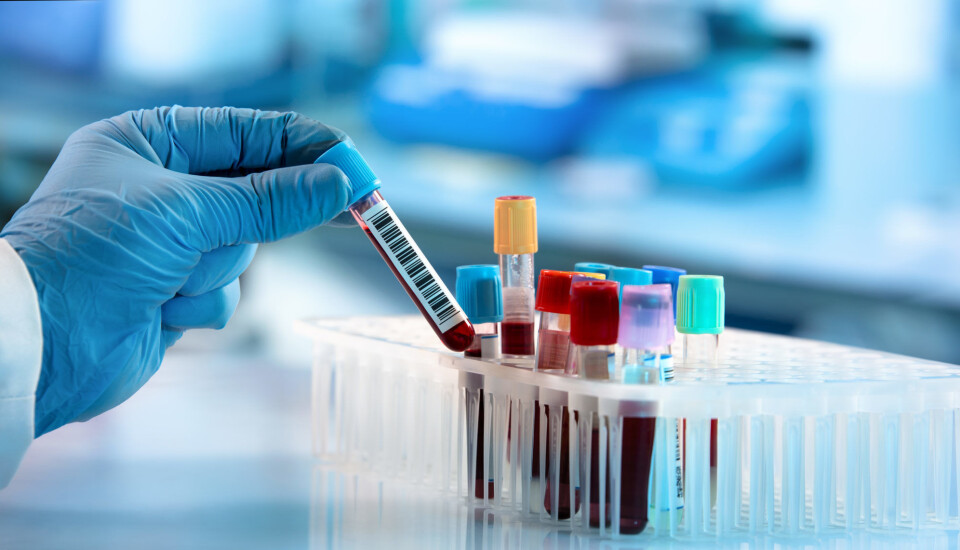This article is produced and financed by NTNU Norwegian University of Science and Technology - read more

Proteins in blood test can reveal and predict disease
An analysis of 5 000 proteins from a blood sample is providing valuable information on a variety of diseases we might get or be at risk for. “Sensational” is the word from Christian Jonasson at the HUNT Research Centre about the US-British-Norwegian study.
Researcher Christian Jonasson believes large-scale protein analyses will be a useful tool for the health service in five to ten years.
“We’ve known that proteins can provide indicators of disease and disease risk,” he says.
“The new thing about this study is that the analyses are being done on a large number of proteins simultaneously – 5 000 out of a total of 30 000 proteins that we have in our bodies. The study has shown patterns for a number of diseases.” Jonasson is affiliated with NTNU’s K.G. Jebsen Center for Genetic Epidemiology.

The American company SomaLogic is behind the development and technology for protein analysis. Researchers at the University of Cambridge and NTNU are collaborating with the company.
Blood samples from 17 000 people are included in the study; 2 500 of them come from HUNT, the Nord-Trøndelag Health Study.
The body’s informer
Despite the fact that the mapping of human hereditary material was completed in 2003, finding links to diseases has not progressed as quickly as many had hoped.
Hereditary material is the actual recipe for your body, and the recipe does not change during your lifetime, even if you do. Jonasson believes proteins are a smarter place to look for disease.
“Protein is a product of the genes, and it changes with the body, the way we live and what we’re exposed to. They capture both our inheritance and the environment. Proteins are potentially a far more accurate carrier of disease and disease risk information than the genes. Speedier diagnosis and accurate risk identification are what the healthcare system dreams of,” says Jonasson.
Found in the blood
Some proteins in the body enter the bloodstream through deliberate secretion to control biological processes. Others leak into the bloodstream due to cell damage or cell death.
Proteins are found in the clear fluid that remains when the platelets and red and white blood cells are removed from the blood. Proteins from both secretion and leakage may carry information on a person’s health status and disease risk.
Searching for patterns
The Norwegian blood samples in the study were taken from the HUNT3 study carried out between 2006 and 2008. Researchers followed this group for an average of five years with the help of information from the diagnostic register in the Nord-Trøndelag Hospital Trust. One thousand people who developed severe heart disease during the follow-up period, out of 50 000 people in the register, were selected for protein measurements.
“We compared these with 1 500 control blood samples that hadn’t developed heart disease. Using advanced statistical methods and machine learning, patterns were found that predicted heart disease in the blood samples taken earlier,” Jonasson says.
To substantiate the data-driven approach, the researchers combined the patterns with biological knowledge, which in turn provided the basis for new data analyses.

Series of diseases
Researchers found patterns for diseases and risk of diseases, such as type 2 diabetes, fatty liver, poor kidney function, heart disease and belly fat. The proteins also revealed information about lifestyle factors such as physical activity, alcohol consumption and smoking. In total, eleven health conditions were included in the study. The patterns found for the diseases included between 13 and 375 proteins.
“The models aren’t equally accurate for all conditions. For example, we found that protein analyses were no better indicators of heart disease than those we already have. However, I believe the accuracy increases when we can analyse a higher proportion of the proteins and improve the methods of analysis. I think it will become possible to provide better indications of several diseases, including serious widespread diseases like cancer and Alzheimer’s,” says Jonasson.
Risk of over-treatment
To the question of whether the method could increase the risk of over-diagnosis, over-treatment and unnecessary drug use, Jonasson thinks everyone is afraid of those possible effects.
“A lot of work still needs to be done. I predict that protein analysis will be one of several methods that, along with other known risk factors, are used to predict the risk of illness,” he says.
The scientific study has just been published in Nature Medicine. Jonasson believes that in the future it will stand as a milestone in the research on proteins as indicators of health and in tailoring treatment and prevention.
“The study shows that the principle is correct and that the method works. But this is probably just the start of new and larger studies with better models, methods and technology,” says Jonasson.
Reference:
S.A. Williams et al. P«lasma protein patterns as comprehensive indicators of health». Nat Med 25, 1851–1857 (2019) doi:10.1038/s41591-019-0665-2
———
Read the Norwegian version of this article at forskning.no


































